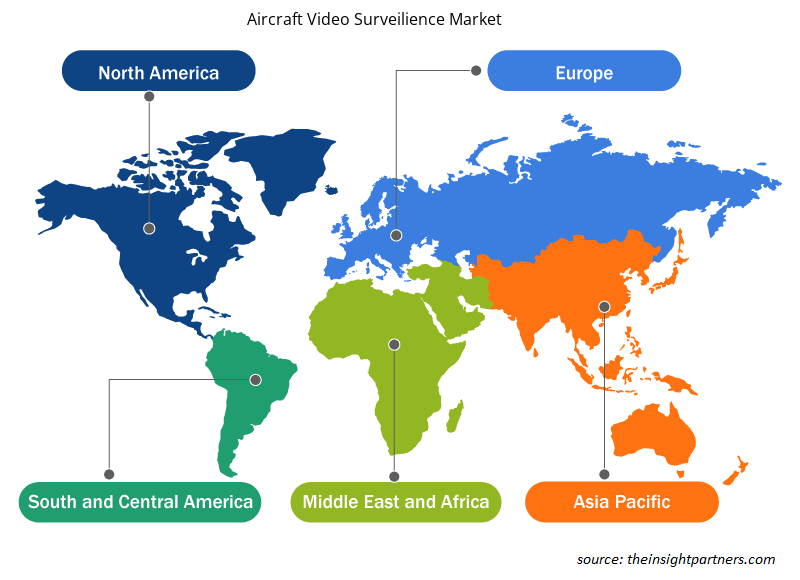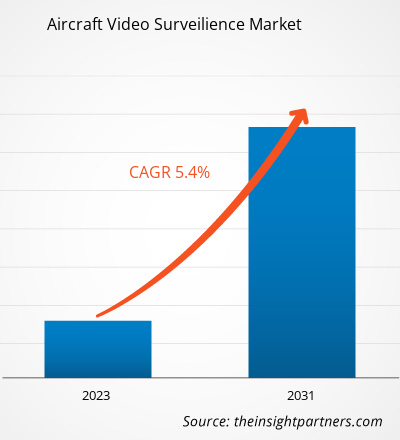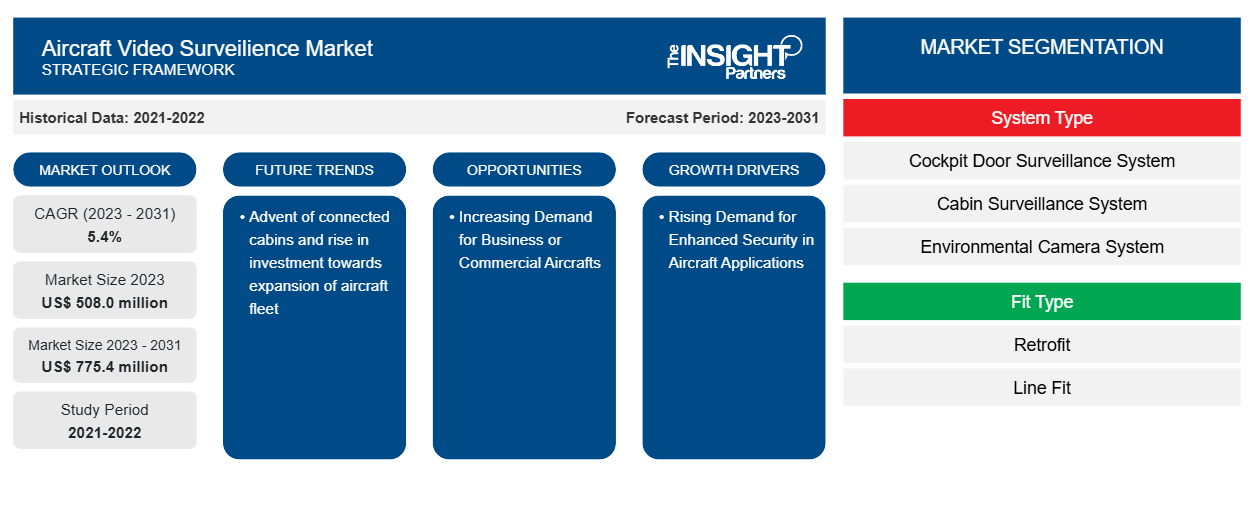Der Markt für Videoüberwachung von Flugzeugen soll von 508,0 Millionen US-Dollar im Jahr 2023 auf 775,4 Millionen US-Dollar im Jahr 2031 anwachsen. Der Markt soll zwischen 2023 und 2031 eine durchschnittliche jährliche Wachstumsrate von 5,4 % verzeichnen. Die Einführung vernetzter Kabinen und steigende Investitionen in die Erweiterung der Flugzeugflotte zählen zu den wichtigsten Trends, die den Markt für Videoüberwachung von Flugzeugen antreiben.
Marktanalyse für Videoüberwachung in Flugzeugen
Der globale Markt für Flugzeug-Videoüberwachung zeigt seit einigen Jahren einen Aufwärtstrend und wird voraussichtlich im Prognosezeitraum einen ähnlichen Trend aufweisen. Das Wachstum des Marktes für Flugzeug-Videoüberwachung ist hauptsächlich auf erhebliche Investitionen in die Luft- und Raumfahrtindustrie zurückzuführen. In den letzten Jahrzehnten ist die Luftfahrtindustrie enorm gewachsen. Die Wachstumsrate des technologischen Wandels war herausragend, was die Nachfrage nach verschiedenen Produkten und Dienstleistungen ankurbelte. Aufgrund der steigenden Nachfrage nach Sicherheitssystemen während des Fluges werden zunehmend Videoüberwachungslösungen für Flugzeuge in Verkehrsflugzeugen eingesetzt. Die zunehmende Zahl von Beschwerden gegen Fluggesellschaften und die Verbesserung der gesetzlichen Sicherheitsstandards haben die Bedeutung von Videoüberwachungslösungen für Flugzeuge unterstrichen .
Marktübersicht zur Videoüberwachung von Flugzeugen
Das Ökosystem des Marktes für Videoüberwachungssysteme für Flugzeuge besteht aus den folgenden Interessengruppen: Komponenten-/Rohstoffanbieter, Integratoren von Videoüberwachungssystemen, Flugzeughersteller und Fluggesellschaften. Rohstoff-/Komponentenanbieter liefern Kleinteile wie Schrauben, Kabel, Kameras, Bedienfelder, Verteilereinheiten, Videorekorder, Montagehalterungen, Kamerakerne und Sensoren, um ein Videoüberwachungssystem für Flugzeuge zu bilden. Rohmaterial wird von verschiedenen Anbietern in der Integrationsanlage für Videoüberwachungssysteme zur weiteren Verarbeitung beschafft. Systemintegratoren führen verschiedene Prozesse durch, wie z. B. Design, Montage und Produktion, um Rohmaterial/Komponenten in das fertige Produkt umzuwandeln. Anbieter von Videoüberwachungssystemen haben eine Reihe spezifischer Lösungen anzubieten, wie z. B. Überwachungssysteme für Cockpittüren, Kabinenüberwachungssysteme und Umgebungskamerasysteme.
Unternehmen wie Collins Aerospace, AD Aerospace und Cabin Avionics gehören zu den führenden Herstellern, die eine breite Palette von Videoüberwachungssystemen anbieten. Flugzeughersteller beschaffen Videoüberwachungssysteme, um sie in Flugzeugflotten wie Großraumflugzeugen und Schmalrumpfflugzeugen zu installieren. Flugzeughersteller arbeiten mit Anbietern von Videoüberwachungslösungen zusammen, um ein bestimmtes Systemset zu beschaffen, das den spezifischen Sicherheitsstandards entspricht. Mit der zunehmenden Digitalisierung konzentrieren sich die Systementwickler auf die Entwicklung einer vernetzten Kabinenlösung mit einer verbesserten Kamerainstallation in Passagierkabinen. Fluggesellschaften nutzen die Aftersales-Services, um die bestehende Flotte im Rahmen der Nachrüstentwicklung mit neuen Videoüberwachungslösungen aufzurüsten.
Passen Sie diesen Bericht Ihren Anforderungen an
Sie erhalten kostenlos individuelle Anpassungen an jedem Bericht, einschließlich Teilen dieses Berichts oder einer Analyse auf Länderebene, eines Excel-Datenpakets sowie tolle Angebote und Rabatte für Start-ups und Universitäten.
-
Holen Sie sich die wichtigsten Markttrends aus diesem Bericht.Dieses KOSTENLOSE Beispiel umfasst eine Datenanalyse von Markttrends bis hin zu Schätzungen und Prognosen.
Markttreiber und Chancen für Videoüberwachung in Flugzeugen
Steigende Nachfrage nach verbesserter Sicherheit bei Flugzeuganwendungen
Die Flotte kommerzieller Flugzeuge hat in den letzten Jahren enorme Veränderungen in Bezug auf Funktionen, Ausrüstung und Merkmale erfahren. Um die Sicherheit für Passagiere und Besatzungsmitglieder zu verbessern, setzen Fluggesellschaften Videoüberwachungssysteme ein. Dies würde ihnen helfen, das Markenimage in einem wettbewerbsintensiven Markt zu verbessern. Darüber hinaus hat nach den Terroranschlägen vom 11. September die Bedeutung von Sicherheits- und Überwachungssystemen insbesondere in kommerziellen Flugzeugen zugenommen. Die Installation moderner Überwachungssysteme in Passagierkabinen und Cockpittüren ist für Fluggesellschaften zu einem wesentlichen Aspekt geworden.
So hat beispielsweise Air Canada neue Richtlinien zur Verbesserung der Sicherheit in Flugzeugen erlassen, wie etwa den Einbau verstärkter Türen, um Eindringlinge am Eindringen ins Cockpit zu hindern, und den Einbau von Cockpitschlössern mit Videoüberwachung zur Überprüfung der Besatzungsmitglieder. Bei den neuen Systemen handelt es sich um vollständig vernetzte Videoüberwachungssysteme, die die Sicherheit im Frachtraum, den Schutz der Flugbesatzung und die Sicherheit im Cockpit verbessern. Neue Produktentwicklungen und ein erhöhter Bedarf an verbesserter Sicherheit beflügeln das Wachstum des Marktes für Flugzeug-Videoüberwachung.
Steigende Nachfrage nach Geschäfts- oder Verkehrsflugzeugen
Der Sektor der Geschäftsluftfahrt erlebt einen deutlichen Anstieg der Nachfrage nach Flugzeugen aufgrund der steigenden Zahl von Geschäftsreisenden. Die Geschäftsluftfahrt wird für Unternehmen zu einem neuen Instrument für die Unternehmensentwicklung und Wachstumsstrategie. Laut Dassault Aviation bieten mehr als 17.000 Geschäftsflugzeuge Dienstleistungen für Kunden auf der ganzen Welt an. Die USA verfügen über zwei Drittel der Flotte, und Länder wie Russland, China und Indien verzeichnen seit einigen Jahren eine zweistellige Wachstumsrate. Die Vorteile von Geschäftsflugzeugen – wie Vertraulichkeit der Reise, Sicherheit, mehrere Zwischenlandungen, Flexibilität in Bezug auf Ankunfts- und Abflugzeiten und Zeitersparnis durch Reduzierung mehrerer Sicherheitskontrollen – gehören zu den Hauptfaktoren, die den Sektor der Geschäftsluftfahrt antreiben. Mit der steigenden Produktion von Geschäftsflugzeugen steigt auch die Nachfrage nach Videoüberwachungslösungen. Videoüberwachungssysteme werden in Geschäftsflugzeugen eingesetzt, um das Situationsbewusstsein zu verbessern und Vorfälle zur Analyse aufzuzeichnen. Darüber hinaus bietet die Lösung Sicherheitsvorteile für Flugpersonal und Passagiere, indem Kameras in der Cockpittür, den Flugzeugaußenseiten und den Kabinen angebracht werden. Collins Aerospace bietet Kabinenvideosysteme und Meggitt PLC bietet Flugzeugkameras. Solche Videoüberwachungslösungen erhöhen die Sicherheit in Flugzeugen.
Segmentierungsanalyse des Marktberichts zur Videoüberwachung von Flugzeugen
Wichtige Segmente, die zur Ableitung der Marktanalyse für Videoüberwachung in Flugzeugen beigetragen haben, sind Systemtyp, Ausstattungstyp und Flugzeugtyp.
- Basierend auf dem Systemtyp wurde der Markt für Flugzeug-Videoüberwachung in Cockpittür-Überwachungssysteme, Kabinenüberwachungssysteme und Umgebungskamerasysteme unterteilt. Das Segment unter 24 Zoll hatte im Jahr 2023 einen größeren Marktanteil.
- Basierend auf der Ausstattungsart wurde der Markt für Flugzeug-Videoüberwachung in Nachrüstung und Serienausstattung unterteilt. Das Segment Transportlinien hatte im Jahr 2023 einen größeren Marktanteil.
- Auf der Grundlage des Flugzeugtyps wurde der Markt in Großraumflugzeuge und Schmalrumpfflugzeuge segmentiert. Das Segment der raffinierten Produkte dominierte den Markt im Jahr 2023.
Marktanteilsanalyse für Videoüberwachung in Flugzeugen nach geografischen Gesichtspunkten
Der geografische Umfang des Marktberichts zur Videoüberwachung von Flugzeugen ist hauptsächlich in fünf Regionen unterteilt: Nordamerika, Europa, Asien-Pazifik, Naher Osten und Afrika sowie Südamerika.
Europa hat den Markt für Videoüberwachung von Flugzeugen im Jahr 2023 dominiert. Die europäische Region umfasst Deutschland, Frankreich, Italien, Russland, Großbritannien und den Rest Europas. Die Luft- und Raumfahrtindustrie in Europa ist ausgereift und wächst aufgrund der Präsenz einer großen Anzahl von Flugzeugherstellern, Anbietern fortschrittlicher Videoüberwachungslösungen und einer qualifizierten Belegschaft mit hoher Geschwindigkeit. In der Region besteht eine enorme Nachfrage nach Videoüberwachungssystemen, da die Flugzeughersteller mit neueren Technologien gut vertraut sind. So bietet Airbus beispielsweise fortschrittliche Sicherheits- und Überwachungssysteme für seine Flugzeugmodelle der Serien A320, A330, A350 und A380 an. Die Videoüberwachungslösungen ermöglichen es der Flugzeugbesatzung, das Flugdeck zu sichern und hohe Sicherheitsstandards an Bord aufrechtzuerhalten.
Regionale Einblicke in den Markt für Videoüberwachung in Flugzeugen
Die regionalen Trends und Faktoren, die den Markt für Videoüberwachung in Flugzeugen während des Prognosezeitraums beeinflussen, wurden von den Analysten von Insight Partners ausführlich erläutert. In diesem Abschnitt werden auch die Marktsegmente und die Geografie für Videoüberwachung in Flugzeugen in Nordamerika, Europa, im asiatisch-pazifischen Raum, im Nahen Osten und Afrika sowie in Süd- und Mittelamerika erörtert.

- Erhalten Sie regionale Daten zum Markt für Videoüberwachung in Flugzeugen
Umfang des Marktberichts zur Videoüberwachung von Flugzeugen
| Berichtsattribut | Details |
|---|---|
| Marktgröße im Jahr 2023 | 508,0 Millionen US-Dollar |
| Marktgröße bis 2031 | 775,4 Millionen US-Dollar |
| Globale CAGR (2023 - 2031) | 5,4 % |
| Historische Daten | 2021-2022 |
| Prognosezeitraum | 2023–2031 |
| Abgedeckte Segmente |
Nach Systemtyp
|
| Abgedeckte Regionen und Länder |
Nordamerika
|
| Marktführer und wichtige Unternehmensprofile |
|
Marktteilnehmerdichte für Videoüberwachung von Flugzeugen: Auswirkungen auf die Geschäftsdynamik verstehen
Der Markt für Videoüberwachungssysteme für Flugzeuge wächst rasant. Dies wird durch die steigende Nachfrage der Endnutzer aufgrund von Faktoren wie sich entwickelnden Verbraucherpräferenzen, technologischen Fortschritten und einem größeren Bewusstsein für die Vorteile des Produkts vorangetrieben. Mit der steigenden Nachfrage erweitern Unternehmen ihr Angebot, entwickeln Innovationen, um die Bedürfnisse der Verbraucher zu erfüllen, und nutzen neue Trends, was das Marktwachstum weiter ankurbelt.
Die Marktteilnehmerdichte bezieht sich auf die Verteilung der Firmen oder Unternehmen, die in einem bestimmten Markt oder einer bestimmten Branche tätig sind. Sie gibt an, wie viele Wettbewerber (Marktteilnehmer) in einem bestimmten Marktraum im Verhältnis zu seiner Größe oder seinem gesamten Marktwert präsent sind.
Die wichtigsten auf dem Markt für Videoüberwachung in Flugzeugen tätigen Unternehmen sind:
- AD Aerospace GmbH
- Aerial View Systems Inc.
- Kabinenavionik Ltd.
- Kappa Optronics GmbH
- Global Eagle Entertainment Inc.
Haftungsausschluss : Die oben aufgeführten Unternehmen sind nicht in einer bestimmten Reihenfolge aufgeführt.

- Überblick über die wichtigsten Akteure auf dem Markt für Videoüberwachung in Flugzeugen
Marktnachrichten und aktuelle Entwicklungen zur Videoüberwachung von Flugzeugen
Der Markt für Videoüberwachung von Flugzeugen wird durch die Erhebung qualitativer und quantitativer Daten nach Primär- und Sekundärforschung bewertet, die wichtige Unternehmensveröffentlichungen, Verbandsdaten und Datenbanken umfasst. Im Folgenden finden Sie eine Liste der Entwicklungen auf dem Markt für Videoüberwachung von Flugzeugen und der Strategien:
- Im Oktober 2022 brachte Optimized Electrotech ein Flaggschiff-Überwachungssystem auf den Markt. Dieses neue Produkt kann in Bereichen mit minimaler Überwachung eingesetzt werden und stärkt zudem das Produktportfolio des Unternehmens.
- Im November 2023 erwarb Signia Aerospace Meeker Aviation und Airfilm Camera Systems. Diese Übernahme stärkte das Produktportfolio des Unternehmens auf dem Markt für Flugzeug-Videoüberwachung.
Marktbericht zur Videoüberwachung von Flugzeugen – Umfang und Ergebnisse
Der Bericht „Marktgröße und Prognose für Videoüberwachung in Flugzeugen (2021–2031)“ bietet eine detaillierte Analyse des Marktes, die die folgenden Bereiche abdeckt:
- Marktgröße und Prognose auf globaler, regionaler und Länderebene für alle wichtigen Marktsegmente, die im Rahmen des Projekts abgedeckt sind
- Marktdynamik wie Treiber, Beschränkungen und wichtige Chancen
- Wichtige Zukunftstrends
- Detaillierte Porter's Five Forces Analyse
- Globale und regionale Marktanalyse mit wichtigen Markttrends, wichtigen Akteuren, Vorschriften und aktuellen Marktentwicklungen
- Branchenlandschaft und Wettbewerbsanalyse, einschließlich Marktkonzentration, Heatmap-Analyse, prominenten Akteuren und aktuellen Entwicklungen
- Detaillierte Firmenprofile mit SWOT-Analyse
- Historische Analyse (2 Jahre), Basisjahr, Prognose (7 Jahre) mit CAGR
- PEST- und SWOT-Analyse
- Marktgröße Wert/Volumen – Global, Regional, Land
- Branchen- und Wettbewerbslandschaft
- Excel-Datensatz
Aktuelle Berichte
Erfahrungsberichte
Grund zum Kauf
- Fundierte Entscheidungsfindung
- Marktdynamik verstehen
- Wettbewerbsanalyse
- Kundeneinblicke
- Marktprognosen
- Risikominimierung
- Strategische Planung
- Investitionsbegründung
- Identifizierung neuer Märkte
- Verbesserung von Marketingstrategien
- Steigerung der Betriebseffizienz
- Anpassung an regulatorische Trends























 Kostenlose Probe anfordern für - Markt für Flugzeugvideoüberwachung
Kostenlose Probe anfordern für - Markt für Flugzeugvideoüberwachung